integration Use Case
Tie Line Manager
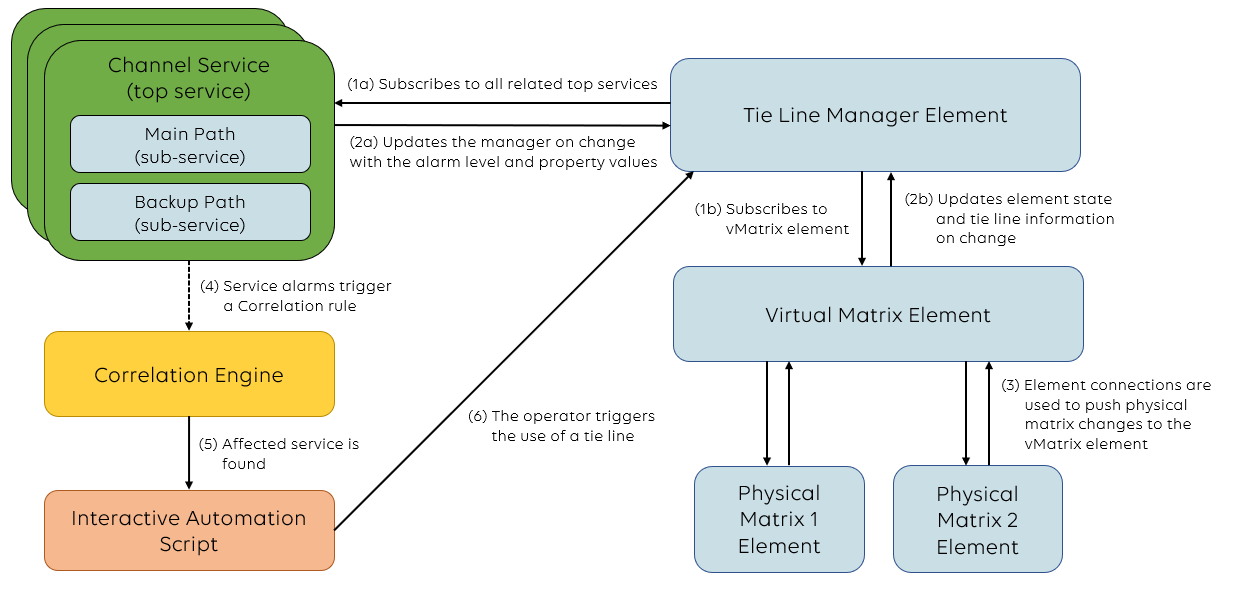
The Tie Line Manager connector is designed to facilitate the management of bidirectional tie lines between video routers located in different sites. Such tie lines are available for redundancy purposes, where the video signal of the backup site can be sent to the main site and used to broadcast. As this can lead to a great deal of complexity, the Tie Line Manager connector makes use of the Generic Virtual Matrix (vMatrix) connector. It applies a layer on top of this vMatrix, where users can monitor their services and select which feed (main or backup) to broadcast.
As illustrated in the solution overview above, the vMatrix connector builds a virtual matrix on top of existing matrices to manage (add, remove, use, or free up) tie lines. The Tie Line Manager extends the functionality of the vMatrix and integrates services into the overall architecture. As such, the Tie Line Manager not only subscribes to the vMatrix element (to receive event states), but also to the related services.
The Tie Line Manager was developed using a publish-subscribe approach, thereby limiting the polling to a minimum. After the vMatrix element and service templates have been configured, the Tie Line Manager will subscribe to the selected vMatrix (through DataMiner standard subscriptions) and services (through InterApp communication). From that moment onwards, the Tie Line Manager will be immediately notified of any update to the tie lines configured on vMatrix, and of the alarm severity and properties of the related services. On top of this, the Tie Line Manager will periodically check the system for new services to subscribe to. With this information, it creates a global view of the solution, so that users can verify the status of each service/channel before deciding whether to switch back to the main path and free up the tie line or switch to the backup path and use a tie line.
Unexpected errors can happen at any time, and the Tie Line Manager will respond to these as soon as possible. Not everything can be handled automatically, as certain decisions need to be made by the operator, for example whether the channel should switch to the backup path and use a tie line. To cope with this, the Tie Line Manager Solution makes use of DataMiner’s Correlation engine to filter services affected by the generated alarms. Whenever an affected service is found, an interactive Automation script is triggered that asks for the attention of an online operator. The operator will get information such as the alarm severity and affected service to support their decision to switch to the backup path or maintain the channel on the main path. If the operator chooses to switch to the backup path, the interactive Automation script will automatically set the channel to use a tie line (via the Tie Line Manager element), and it will switch the channel’s service feed to the backup path. Before deciding on the switch, the operator can also compare the main and backup feed. In that case, both feeds will be sourced to two pre-defined output ports. The operator can then decide to do the switch or have no action performed by the Automation script and the Tie Line Manager element.
USE CASE DETAILS
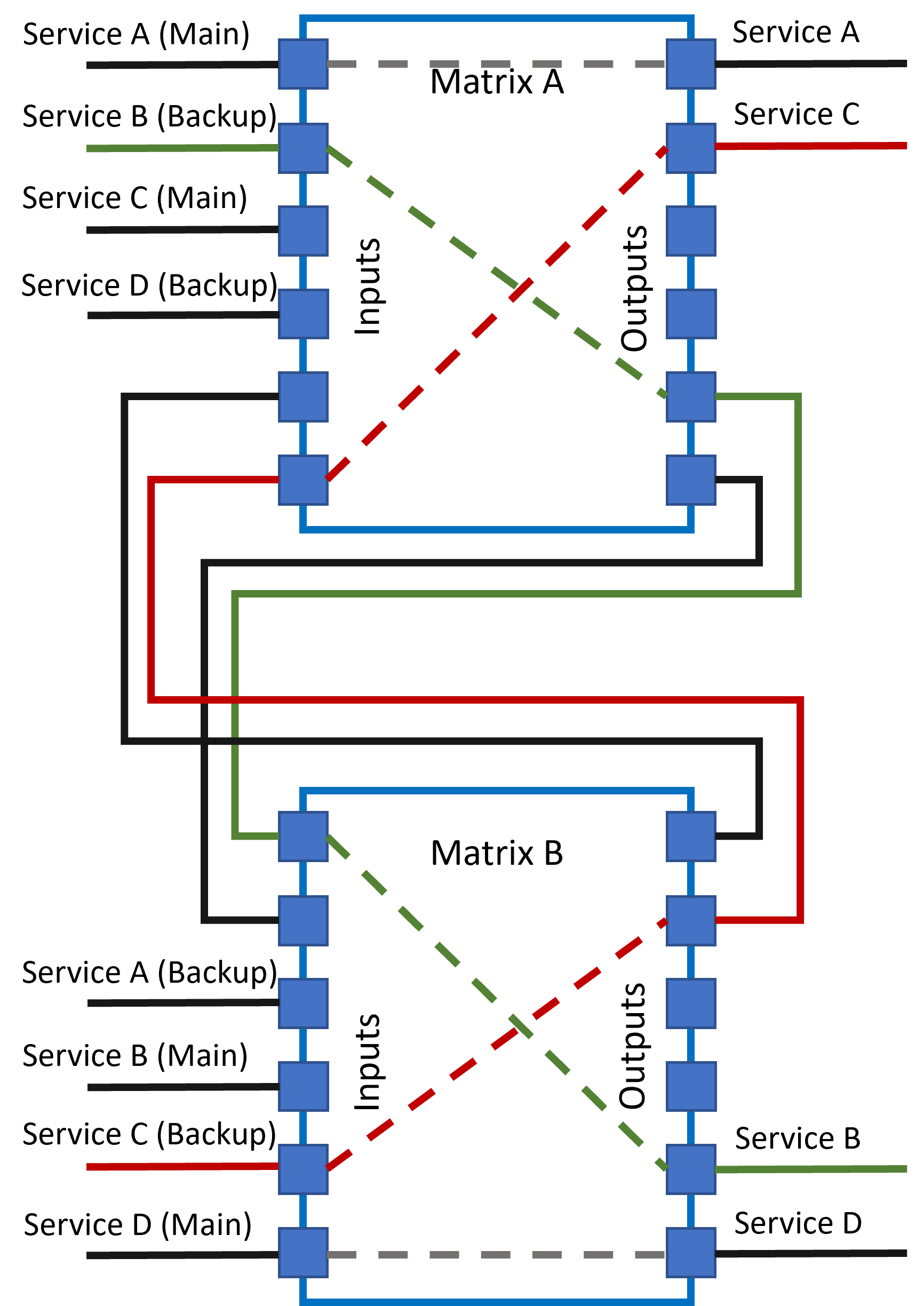 This image illustrates the bidirectional tie lines between video routers located in different sites. It shows a generic scenario where Service A and Service D are routed from their main video router. As such, the Service A and D main feeds are being used to broadcast. Nevertheless, video routers are prepared to receive the service feed from a backup path as well through the usage of a tie line (connection between Matrix A and Matrix B). These tie lines are shown in red and green in the image. The video router of Service C transmits the backup feed received from the red tie line. The same happens for Service B with the green tie line. To abstract the user from all this complexity, the solution makes use of the Generic Virtual Matrix (vMatrix) connector.
This image illustrates the bidirectional tie lines between video routers located in different sites. It shows a generic scenario where Service A and Service D are routed from their main video router. As such, the Service A and D main feeds are being used to broadcast. Nevertheless, video routers are prepared to receive the service feed from a backup path as well through the usage of a tie line (connection between Matrix A and Matrix B). These tie lines are shown in red and green in the image. The video router of Service C transmits the backup feed received from the red tie line. The same happens for Service B with the green tie line. To abstract the user from all this complexity, the solution makes use of the Generic Virtual Matrix (vMatrix) connector.
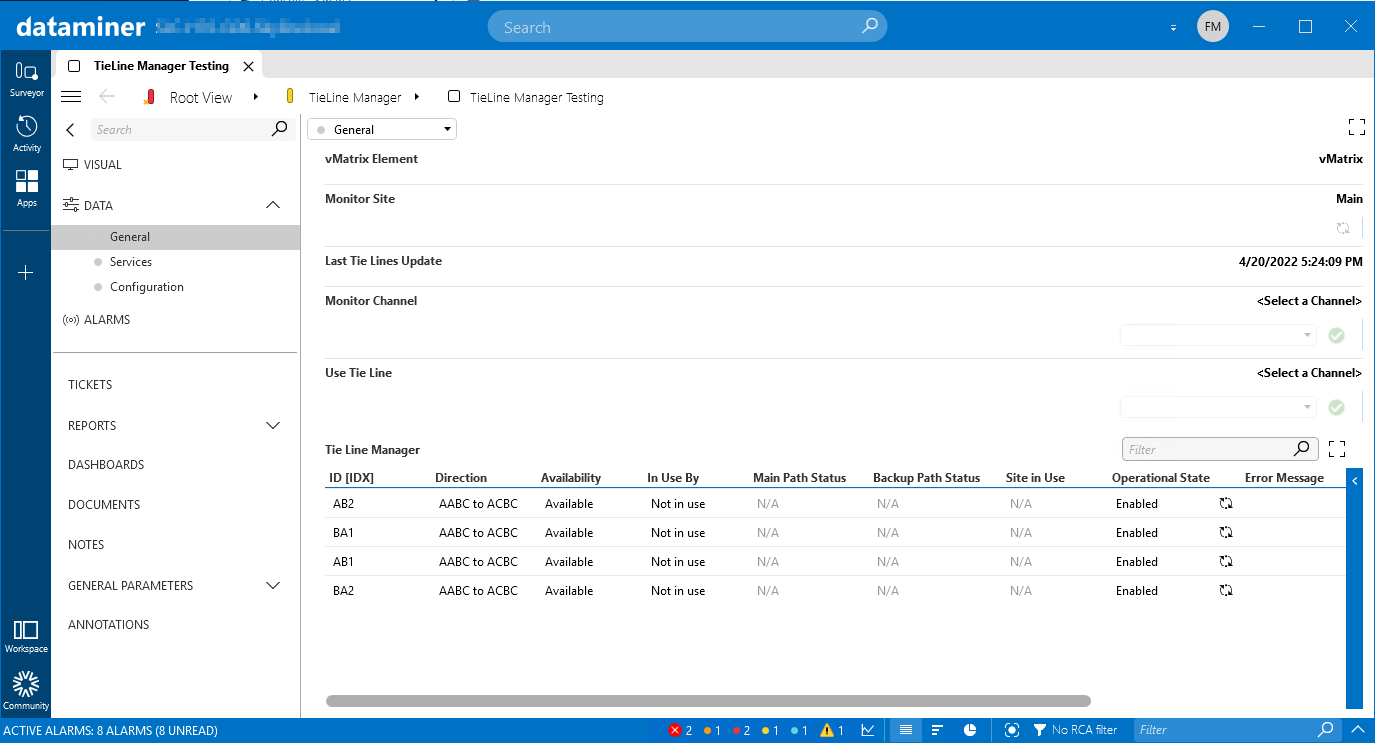 On the General page of the Tie Line Manager, you can monitor and manage the main functionality of the connector. You can verify the vMatrix element to which it is connected, select the site (main or backup) that should be used for comparing the main and backup feeds of a service, set a service for monitoring (with the "Monitor Channel" parameter), and select a service for the backup path (with the "Use Tie Line" parameter). In the "Tie Line Manager" table, you can monitor the state of existing tie lines and check which services are using them, if any.
On the General page of the Tie Line Manager, you can monitor and manage the main functionality of the connector. You can verify the vMatrix element to which it is connected, select the site (main or backup) that should be used for comparing the main and backup feeds of a service, set a service for monitoring (with the "Monitor Channel" parameter), and select a service for the backup path (with the "Use Tie Line" parameter). In the "Tie Line Manager" table, you can monitor the state of existing tie lines and check which services are using them, if any.
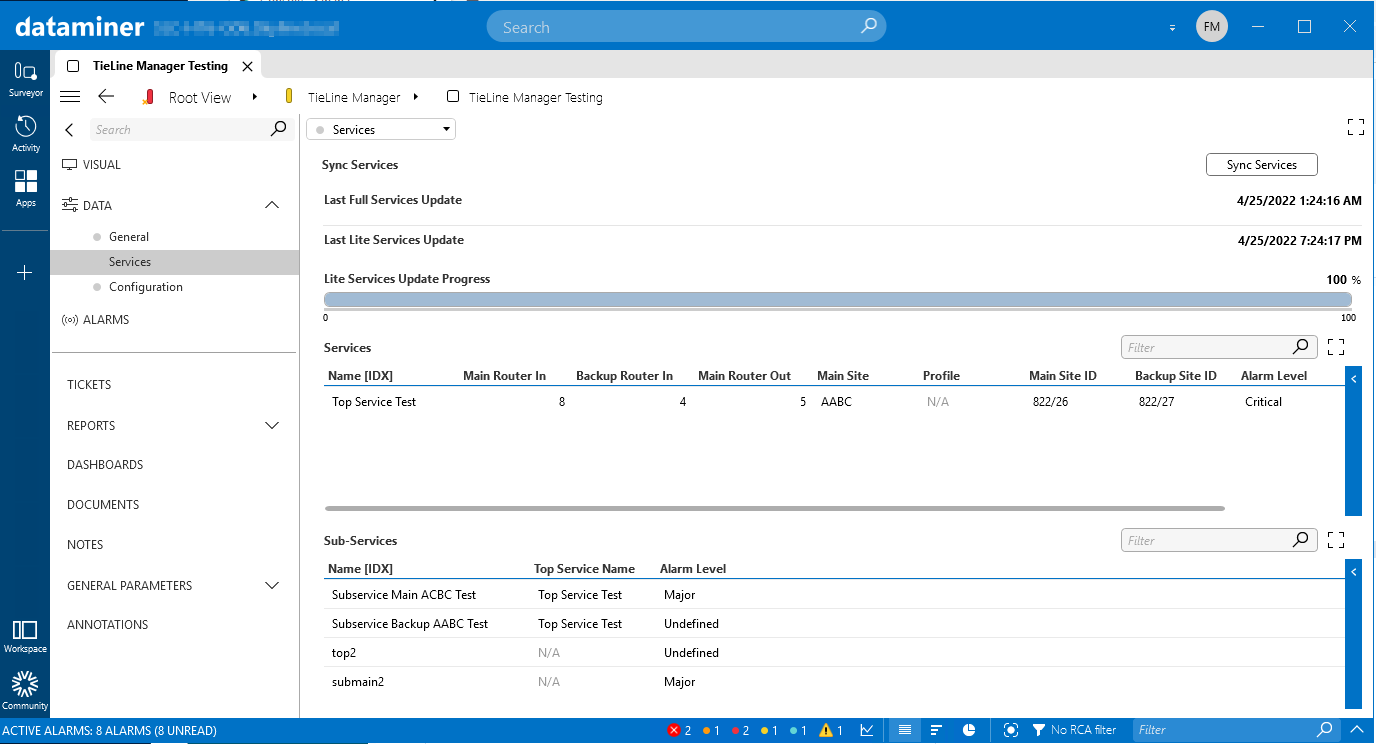 The Services page displays all services in the DataMiner System that are related to the Tie Line Manager Solution. Note that each service consists of two sub-services (for the main and backup path). Here you can monitor the state of the paths of each service, as well as the service properties.
The Services page displays all services in the DataMiner System that are related to the Tie Line Manager Solution. Note that each service consists of two sub-services (for the main and backup path). Here you can monitor the state of the paths of each service, as well as the service properties.
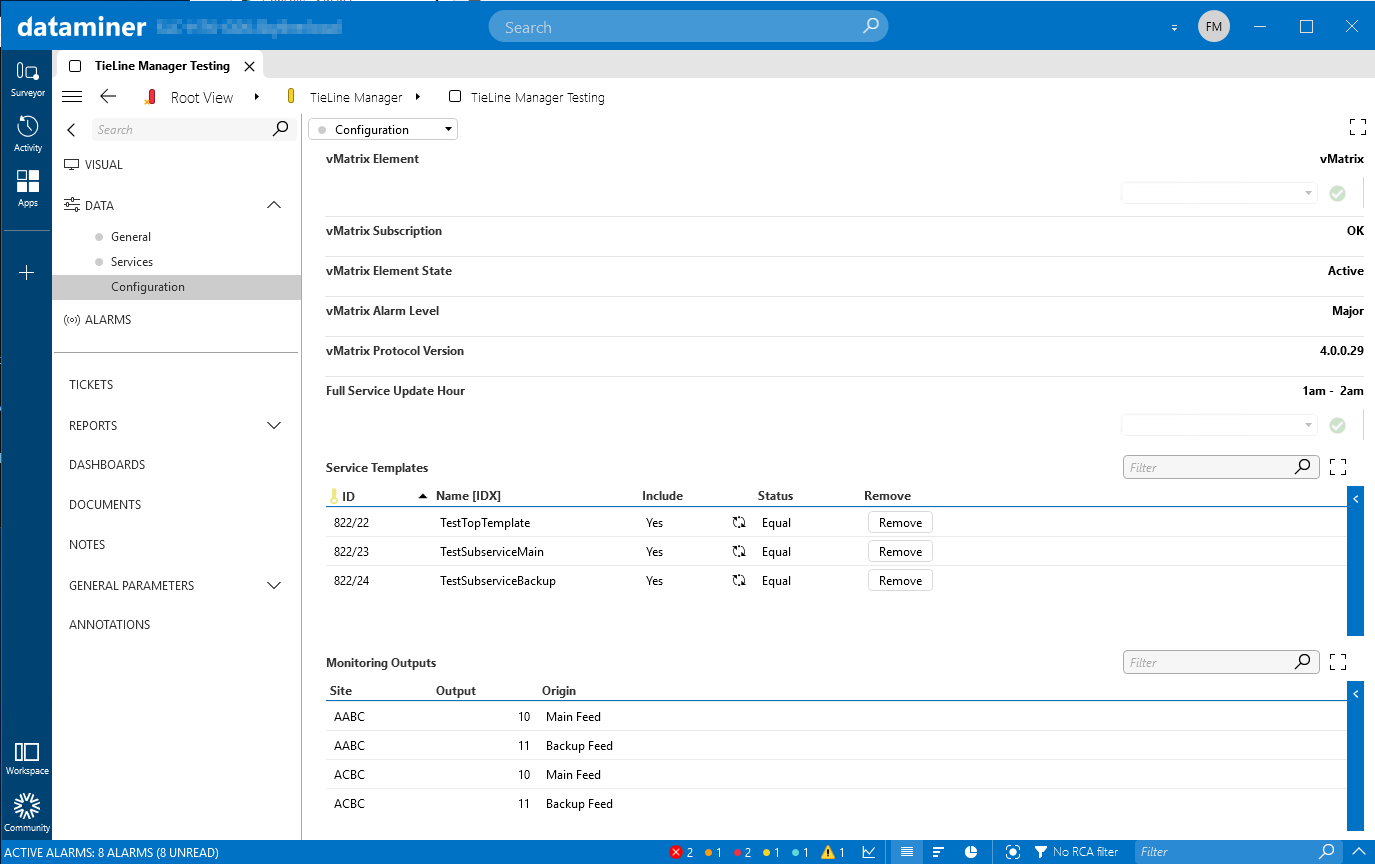 The Configuration page allows you to set the initial configuration of the connector. To begin with, you need to select one of the vMatrix elements detected in the system. In the Services Templates table, you can select which service templates should be considered services of the Tie Line Manager Solution. The Monitoring Outputs table allows you to select the outputs to be used by each matrix for comparing main and backup feeds. Finally, as the search for new services in the entire DMS is a heavy task, the connector only does it once a day. In the "Full Service Update Hour" box, you can select the most convenient timeslot for this action.
The Configuration page allows you to set the initial configuration of the connector. To begin with, you need to select one of the vMatrix elements detected in the system. In the Services Templates table, you can select which service templates should be considered services of the Tie Line Manager Solution. The Monitoring Outputs table allows you to select the outputs to be used by each matrix for comparing main and backup feeds. Finally, as the search for new services in the entire DMS is a heavy task, the connector only does it once a day. In the "Full Service Update Hour" box, you can select the most convenient timeslot for this action.
1 thought on “Tie Line Manager”
Leave a Reply
You must be logged in to post a comment.
Thanks very much Flavio!